our company
Custom Made Excellence
Our experienced team of refractory experts work closely with each customer to select the best material based on their specific requirements. We use only the highest quality refractory products from trusted manufacturers to produce our precast products. Through the years we have cultivated strong relationships with our supplier partners, including many companies who we private label for. Quality control, continuous improvement, and setting the standard with the latest technology are all trademarks of our operations.
Strength, Quality and A Trusted Name
Chase Nedrow Manufacturing was founded in 1980 by James (Jim) Chase and Charles (Skip) Nedrow to specialize in the design and manufacture of precast refractory products. With the advancement of low moisture, low cement castables of the time, properties approaching that of pressed firebrick were possible using monolithic refractories.Today, with the development of even newer high-tech castables and our high firing capabilities up to 2400 °F, precast products are routinely replacing refractory brick within furnaces, making furnace turnarounds faster than ever.
The History Of Steelmaking
 The earliest known artifacts of iron were found in the Egyptian Pyramids, built over 5000 years ago. Chemical analysis proved that the source of this iron come from meteors. In early Egyptian writings it was called ba-en-pet, variously interpreted as “hard stone from the sky” and “marvel from heaven.” Having descended from the gods, iron assumed a mystical, and at times, sacred property in the eyes of primitive man. In meteoric iron, primal man had an iron-nickel alloy, closely akin to steel… In some respects superior to any industrial metal manufactured prior to the 1880’s.
The earliest known artifacts of iron were found in the Egyptian Pyramids, built over 5000 years ago. Chemical analysis proved that the source of this iron come from meteors. In early Egyptian writings it was called ba-en-pet, variously interpreted as “hard stone from the sky” and “marvel from heaven.” Having descended from the gods, iron assumed a mystical, and at times, sacred property in the eyes of primitive man. In meteoric iron, primal man had an iron-nickel alloy, closely akin to steel… In some respects superior to any industrial metal manufactured prior to the 1880’s.
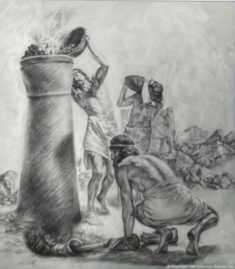 Herodotus tells us that the Chalybes found out how to convert iron into steel sixteen centuries before Christ. While smelting iron-rich sand on the southern shores of the Black Sea, these early smiths at first produced spongy lumps of metal that were friable and easily shattered. Later, by reheating the lumps to a bright redness and hammering the pieces while still hot, they were able to produce a malleable iron. As this iron was reheated, it absorbed carbon from contact with the charcoal, thus gaining in hardness. By perfecting this carburizing process and introducing higher proportions of carbon through repeated forgings, the Chalybes produced a metal so superior that it revolutionized weaponry, as well as tools and implements, thus changing the course of civilization. Mankind had truly entered the Iron Age.
Herodotus tells us that the Chalybes found out how to convert iron into steel sixteen centuries before Christ. While smelting iron-rich sand on the southern shores of the Black Sea, these early smiths at first produced spongy lumps of metal that were friable and easily shattered. Later, by reheating the lumps to a bright redness and hammering the pieces while still hot, they were able to produce a malleable iron. As this iron was reheated, it absorbed carbon from contact with the charcoal, thus gaining in hardness. By perfecting this carburizing process and introducing higher proportions of carbon through repeated forgings, the Chalybes produced a metal so superior that it revolutionized weaponry, as well as tools and implements, thus changing the course of civilization. Mankind had truly entered the Iron Age.
 Over 5000 years ago, the Egyptians made primitive tools from meteoric iron. One thousand years later they learned how to smelt this metal. Then (circa, 1600 B.C.), the Chalybes of Pontus (northeastern Turkey) discovered forging and carburizing. With this development, civilization entered the Iron Age. 700 years into the Iron Age early smiths were able to produce an iron as fine as any known today by solving the secrets of quenching and tempering. As a result, the Iron Age replaced the Bronze Age and hastened the spread of society by providing a metal that was less expensive than any other, yet superior in almost every respect.
Over 5000 years ago, the Egyptians made primitive tools from meteoric iron. One thousand years later they learned how to smelt this metal. Then (circa, 1600 B.C.), the Chalybes of Pontus (northeastern Turkey) discovered forging and carburizing. With this development, civilization entered the Iron Age. 700 years into the Iron Age early smiths were able to produce an iron as fine as any known today by solving the secrets of quenching and tempering. As a result, the Iron Age replaced the Bronze Age and hastened the spread of society by providing a metal that was less expensive than any other, yet superior in almost every respect.
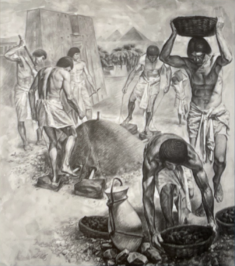 Some 4000 years ago, the Egyptians were the first to smelt iron. Their blast furnace was simply a mound of earth filled with iron ore and charcoal. Bellows of skin supplied air. After the charcoal was fully burned, the mound was opened and the lump of iron lifted out. It is believed that this first smelting of iron was accidental. Iron ore was mistaken for copper ore. When these early smiths attempted to shape man-made iron, they were unsuccessful because the ore contained only traces of nickel or none at all. This early iron was too soft to hold a cutting edge. So there was no incentive to smelt iron on a large scale until important metallurgical discoveries were made some four centuries alter.
Some 4000 years ago, the Egyptians were the first to smelt iron. Their blast furnace was simply a mound of earth filled with iron ore and charcoal. Bellows of skin supplied air. After the charcoal was fully burned, the mound was opened and the lump of iron lifted out. It is believed that this first smelting of iron was accidental. Iron ore was mistaken for copper ore. When these early smiths attempted to shape man-made iron, they were unsuccessful because the ore contained only traces of nickel or none at all. This early iron was too soft to hold a cutting edge. So there was no incentive to smelt iron on a large scale until important metallurgical discoveries were made some four centuries alter.
 Steel was first produced in Hyderābād, India around 400 B.C. Here, artisans combined black magnetite sand, bamboo charcoal and the leaves of aceous plants. This charge was sealed in a clay crucible and smelted to yield buttons of metal which were alternately melted and cooled to form 2 to 5 pound pieces known as wootz cakes. This high grade steel was discovered by Persian merchants and carried to Damascus where armorers heated and hammered the cakes into the famous Damascus Blades. After annealing, these blades were quenched and drawn to desired hardness. Polishing and etching then served to bring the distinctive “damask” pattern to the surface. When finished, the blades were so supple that they could bend from hilt to tip and still take a cutting edge that has never been surpassed.
Steel was first produced in Hyderābād, India around 400 B.C. Here, artisans combined black magnetite sand, bamboo charcoal and the leaves of aceous plants. This charge was sealed in a clay crucible and smelted to yield buttons of metal which were alternately melted and cooled to form 2 to 5 pound pieces known as wootz cakes. This high grade steel was discovered by Persian merchants and carried to Damascus where armorers heated and hammered the cakes into the famous Damascus Blades. After annealing, these blades were quenched and drawn to desired hardness. Polishing and etching then served to bring the distinctive “damask” pattern to the surface. When finished, the blades were so supple that they could bend from hilt to tip and still take a cutting edge that has never been surpassed.
 When the Roman legions withdrew from Britain in the early 5th century, most of their civilizing influences disappeared with them. The only craft to continue through the “Dark Ages” was that of the smith, for the Anglo-Saxons who took over the land needed iron for weapons and farm tools. By the 7th century, Christianity was established in Britain. During the next three hundred years, the most monastic orders were largely responsible for keeping iron-working skills alive. By the 10th century, it was regarded as such a vital art that St. Dunstan, then Archbishop of Canterbury, actually had a forge in his own quarters.
When the Roman legions withdrew from Britain in the early 5th century, most of their civilizing influences disappeared with them. The only craft to continue through the “Dark Ages” was that of the smith, for the Anglo-Saxons who took over the land needed iron for weapons and farm tools. By the 7th century, Christianity was established in Britain. During the next three hundred years, the most monastic orders were largely responsible for keeping iron-working skills alive. By the 10th century, it was regarded as such a vital art that St. Dunstan, then Archbishop of Canterbury, actually had a forge in his own quarters.
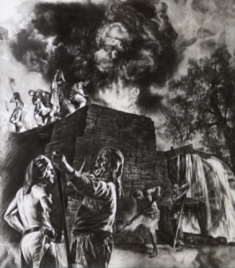 Precursor of the blast furnace was the stuckofen, widely used in eastern Europe through the 13th century. With 16-foot stacks, and using water power to generate a sufficient blast of heat, this furnace made possible the production of molten iron directly from ore. But much of the first cast iron was too brittle for the forge. Early in the 14th century, iron smelters began to use a new term: flussofen or flow oven, clearly indicating a consistent ability to produce malleable iron. Thus was perfected the blast furnace. The first one on record was erected in 1340 at Marches-les-Dames in Belgium.
Precursor of the blast furnace was the stuckofen, widely used in eastern Europe through the 13th century. With 16-foot stacks, and using water power to generate a sufficient blast of heat, this furnace made possible the production of molten iron directly from ore. But much of the first cast iron was too brittle for the forge. Early in the 14th century, iron smelters began to use a new term: flussofen or flow oven, clearly indicating a consistent ability to produce malleable iron. Thus was perfected the blast furnace. The first one on record was erected in 1340 at Marches-les-Dames in Belgium.
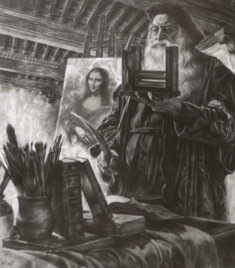 While rolls and drawing benches — used to flatten strips of gold and silver — were in limited use from the 12th through the 14th centuries, it was not until 1486 that a rolling mill for heavies work was first designed. Leonardo da Vinci was the architect and, as with so many of his inventions, he was years ahead of his time. The first known rod mills were not actually built until the early 16th century — in Belgium and Germany. Then, in 1565, a steelworks in England acquired a unique mill capability… Rolling flat plates from red hot iron bars. By 1720, rolling mills were in common use throughout Europe.
While rolls and drawing benches — used to flatten strips of gold and silver — were in limited use from the 12th through the 14th centuries, it was not until 1486 that a rolling mill for heavies work was first designed. Leonardo da Vinci was the architect and, as with so many of his inventions, he was years ahead of his time. The first known rod mills were not actually built until the early 16th century — in Belgium and Germany. Then, in 1565, a steelworks in England acquired a unique mill capability… Rolling flat plates from red hot iron bars. By 1720, rolling mills were in common use throughout Europe.
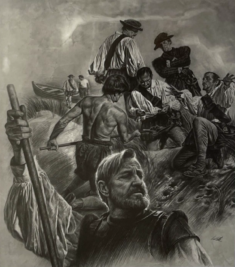 Scarcity of iron was one of the greatest obstacles hampering early settlement in the New World. By 1584 an expedition sent by Sir Walter Raleigh found traces of iron ore on Roanoke Island, off the coast of North Caroline. Reports brought back were so encouraging that Raleigh sent out a second expedition to establish a permanent settlement on the island. These settlers soon found sizable deposits of iron ore… the first in North America.
Scarcity of iron was one of the greatest obstacles hampering early settlement in the New World. By 1584 an expedition sent by Sir Walter Raleigh found traces of iron ore on Roanoke Island, off the coast of North Caroline. Reports brought back were so encouraging that Raleigh sent out a second expedition to establish a permanent settlement on the island. These settlers soon found sizable deposits of iron ore… the first in North America.
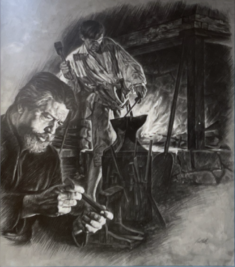 Four months after the Jamestown (Virginia) colony was established, Captain John Smith wrote, “we have no houses to cover us, our tents are rotten, our cabins worse than nought; our best commodity is iron, which we make into little chisels.” A man named James Read was the only blacksmith among the first colonists. It is believed that he was the first to forge this native iron. Because iron was previously imported from England at astronomical prices, Read’s forge not only provided the colonists with badly needed tools, but also made possible their first step toward commercial independence.
Four months after the Jamestown (Virginia) colony was established, Captain John Smith wrote, “we have no houses to cover us, our tents are rotten, our cabins worse than nought; our best commodity is iron, which we make into little chisels.” A man named James Read was the only blacksmith among the first colonists. It is believed that he was the first to forge this native iron. Because iron was previously imported from England at astronomical prices, Read’s forge not only provided the colonists with badly needed tools, but also made possible their first step toward commercial independence.
 A group called the Virginia Company, chartered by the Crown to colonize Virginia, made the first attempts to establish a large-volume ironworks in the New World. The first 3 times their efforts were dismal failures. The fourth plant, constructed in the early 1620’s at Falling Creek, looked as though it would be a success. Then, on March 22, 1622, Indian Chief – Openchancanough led his warriors against the out-numbered colonists and slaughtered nearly all of them, forcing the hapless Virginia Company to abandon its entire industrial venture. This move halted Virginia’s iron-making progress for almost 100 years.
A group called the Virginia Company, chartered by the Crown to colonize Virginia, made the first attempts to establish a large-volume ironworks in the New World. The first 3 times their efforts were dismal failures. The fourth plant, constructed in the early 1620’s at Falling Creek, looked as though it would be a success. Then, on March 22, 1622, Indian Chief – Openchancanough led his warriors against the out-numbered colonists and slaughtered nearly all of them, forcing the hapless Virginia Company to abandon its entire industrial venture. This move halted Virginia’s iron-making progress for almost 100 years.
 Raynham Forge was built in 1656, springing from the defunct Hammersmith Ironworks… often called “the birthplace of the American Iron and Steel Industry.” Hammersmith was defeated by financial mismanagement, but its group of highly skilled workers went on to found a new ironworks in Plymouth Colony. This was Raynham Forge, and it produced vitally needed, high-grade iron for more than two centuries, earning a place in history as the oldest iron manufacturer in New England.
Raynham Forge was built in 1656, springing from the defunct Hammersmith Ironworks… often called “the birthplace of the American Iron and Steel Industry.” Hammersmith was defeated by financial mismanagement, but its group of highly skilled workers went on to found a new ironworks in Plymouth Colony. This was Raynham Forge, and it produced vitally needed, high-grade iron for more than two centuries, earning a place in history as the oldest iron manufacturer in New England.
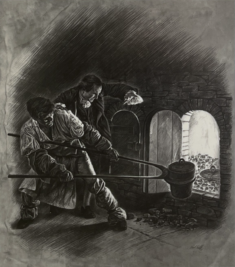 The crucible process was practiced in ancient India while manufacturing the celebrated wootz steel. Over the ages the techniques of this process were apparently lost. They were later rediscovered in colonial England by Benjamin Huntsman, a Quaker clockmaker, who was seeking a superior steel for his clock and watch springs. By 1740, Huntsman was producing crucible steel of an excellent quality. Bars of blister steel were broken into small pieces, placed in fire-clay crucibles, and fired for several hours in charcoal furnaces. When “steeling” was completed, the crucibles were removed and the molten steel was poured into molds. Because of its superior quality, this hard, dense, crucible steel was soon in demand throughout the continent.
The crucible process was practiced in ancient India while manufacturing the celebrated wootz steel. Over the ages the techniques of this process were apparently lost. They were later rediscovered in colonial England by Benjamin Huntsman, a Quaker clockmaker, who was seeking a superior steel for his clock and watch springs. By 1740, Huntsman was producing crucible steel of an excellent quality. Bars of blister steel were broken into small pieces, placed in fire-clay crucibles, and fired for several hours in charcoal furnaces. When “steeling” was completed, the crucibles were removed and the molten steel was poured into molds. Because of its superior quality, this hard, dense, crucible steel was soon in demand throughout the continent.
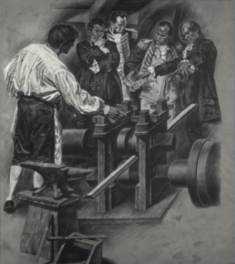 In 1780 the British Navy sent a quantity of scrap iron to Henry Cort’s ironworks in Fontley, England, with the request that he convert this metal into formed products for their ships. For the next three years Cort experimented with the production of shaped bars. Then, in 1783, he was issued a patent for a mill with grooved rolls. Cort had successfully perfected a puddling furnace which helped to convert the old iron ship ballast into formed wrought iron. Although Cort was not the inventor of grooved rolls or the puddling furnace, he was the first person to combine them successfully. Known as the father of the modern rolling mill, his developments ended the smith’s long supremacy and paved the way for the fabrication of shaped products.
In 1780 the British Navy sent a quantity of scrap iron to Henry Cort’s ironworks in Fontley, England, with the request that he convert this metal into formed products for their ships. For the next three years Cort experimented with the production of shaped bars. Then, in 1783, he was issued a patent for a mill with grooved rolls. Cort had successfully perfected a puddling furnace which helped to convert the old iron ship ballast into formed wrought iron. Although Cort was not the inventor of grooved rolls or the puddling furnace, he was the first person to combine them successfully. Known as the father of the modern rolling mill, his developments ended the smith’s long supremacy and paved the way for the fabrication of shaped products.
The History Of Steelmaking
 The earliest known artifacts of iron were found in the Egyptian Pyramids, built over 5000 years ago. Chemical analysis proved that the source of this iron come from meteors. In early Egyptian writings it was called ba-en-pet, variously interpreted as “hard stone from the sky” and “marvel from heaven.” Having descended from the gods, iron assumed a mystical, and at times, sacred property in the eyes of primitive man. In meteoric iron, primal man had an iron-nickel alloy, closely akin to steel… In some respects superior to any industrial metal manufactured prior to the 1880’s.
The earliest known artifacts of iron were found in the Egyptian Pyramids, built over 5000 years ago. Chemical analysis proved that the source of this iron come from meteors. In early Egyptian writings it was called ba-en-pet, variously interpreted as “hard stone from the sky” and “marvel from heaven.” Having descended from the gods, iron assumed a mystical, and at times, sacred property in the eyes of primitive man. In meteoric iron, primal man had an iron-nickel alloy, closely akin to steel… In some respects superior to any industrial metal manufactured prior to the 1880’s. Herodotus tells us that the Chalybes found out how to convert iron into steel sixteen centuries before Christ. While smelting iron-rich sand on the southern shores of the Black Sea, these early smiths at first produced spongy lumps of metal that were friable and easily shattered. Later, by reheating the lumps to a bright redness and hammering the pieces while still hot, they were able to produce a malleable iron. As this iron was reheated, it absorbed carbon from contact with the charcoal, thus gaining in hardness. By perfecting this carburizing process and introducing higher proportions of carbon through repeated forgings, the Chalybes produced a metal so superior that it revolutionized weaponry, as well as tools and implements, thus changing the course of civilization. Mankind had truly entered the Iron Age.
Herodotus tells us that the Chalybes found out how to convert iron into steel sixteen centuries before Christ. While smelting iron-rich sand on the southern shores of the Black Sea, these early smiths at first produced spongy lumps of metal that were friable and easily shattered. Later, by reheating the lumps to a bright redness and hammering the pieces while still hot, they were able to produce a malleable iron. As this iron was reheated, it absorbed carbon from contact with the charcoal, thus gaining in hardness. By perfecting this carburizing process and introducing higher proportions of carbon through repeated forgings, the Chalybes produced a metal so superior that it revolutionized weaponry, as well as tools and implements, thus changing the course of civilization. Mankind had truly entered the Iron Age. Over 5000 years ago, the Egyptians made primitive tools from meteoric iron. One thousand years later they learned how to smelt this metal. Then (circa, 1600 B.C.), the Chalybes of Pontus (northeastern Turkey) discovered forging and carburizing. With this development, civilization entered the Iron Age. 700 years into the Iron Age early smiths were able to produce an iron as fine as any known today by solving the secrets of quenching and tempering. As a result, the Iron Age replaced the Bronze Age and hastened the spread of society by providing a metal that was less expensive than any other, yet superior in almost every respect.
Over 5000 years ago, the Egyptians made primitive tools from meteoric iron. One thousand years later they learned how to smelt this metal. Then (circa, 1600 B.C.), the Chalybes of Pontus (northeastern Turkey) discovered forging and carburizing. With this development, civilization entered the Iron Age. 700 years into the Iron Age early smiths were able to produce an iron as fine as any known today by solving the secrets of quenching and tempering. As a result, the Iron Age replaced the Bronze Age and hastened the spread of society by providing a metal that was less expensive than any other, yet superior in almost every respect. Some 4000 years ago, the Egyptians were the first to smelt iron. Their blast furnace was simply a mound of earth filled with iron ore and charcoal. Bellows of skin supplied air. After the charcoal was fully burned, the mound was opened and the lump of iron lifted out. It is believed that this first smelting of iron was accidental. Iron ore was mistaken for copper ore. When these early smiths attempted to shape man-made iron, they were unsuccessful because the ore contained only traces of nickel or none at all. This early iron was too soft to hold a cutting edge. So there was no incentive to smelt iron on a large scale until important metallurgical discoveries were made some four centuries alter.
Some 4000 years ago, the Egyptians were the first to smelt iron. Their blast furnace was simply a mound of earth filled with iron ore and charcoal. Bellows of skin supplied air. After the charcoal was fully burned, the mound was opened and the lump of iron lifted out. It is believed that this first smelting of iron was accidental. Iron ore was mistaken for copper ore. When these early smiths attempted to shape man-made iron, they were unsuccessful because the ore contained only traces of nickel or none at all. This early iron was too soft to hold a cutting edge. So there was no incentive to smelt iron on a large scale until important metallurgical discoveries were made some four centuries alter.
 Steel was first produced in Hyderābād, India around 400 B.C. Here, artisans combined black magnetite sand, bamboo charcoal and the leaves of aceous plants. This charge was sealed in a clay crucible and smelted to yield buttons of metal which were alternately melted and cooled to form 2 to 5 pound pieces known as wootz cakes. This high grade steel was discovered by Persian merchants and carried to Damascus where armorers heated and hammered the cakes into the famous Damascus Blades. After annealing, these blades were quenched and drawn to desired hardness. Polishing and etching then served to bring the distinctive “damask” pattern to the surface. When finished, the blades were so supple that they could bend from hilt to tip and still take a cutting edge that has never been surpassed.
Steel was first produced in Hyderābād, India around 400 B.C. Here, artisans combined black magnetite sand, bamboo charcoal and the leaves of aceous plants. This charge was sealed in a clay crucible and smelted to yield buttons of metal which were alternately melted and cooled to form 2 to 5 pound pieces known as wootz cakes. This high grade steel was discovered by Persian merchants and carried to Damascus where armorers heated and hammered the cakes into the famous Damascus Blades. After annealing, these blades were quenched and drawn to desired hardness. Polishing and etching then served to bring the distinctive “damask” pattern to the surface. When finished, the blades were so supple that they could bend from hilt to tip and still take a cutting edge that has never been surpassed.
 When the Roman legions withdrew from Britain in the early 5th century, most of their civilizing influences disappeared with them. The only craft to continue through the “Dark Ages” was that of the smith, for the Anglo-Saxons who took over the land needed iron for weapons and farm tools. By the 7th century, Christianity was established in Britain. During the next three hundred years, the most monastic orders were largely responsible for keeping iron-working skills alive. By the 10th century, it was regarded as such a vital art that St. Dunstan, then Archbishop of Canterbury, actually had a forge in his own quarters.
When the Roman legions withdrew from Britain in the early 5th century, most of their civilizing influences disappeared with them. The only craft to continue through the “Dark Ages” was that of the smith, for the Anglo-Saxons who took over the land needed iron for weapons and farm tools. By the 7th century, Christianity was established in Britain. During the next three hundred years, the most monastic orders were largely responsible for keeping iron-working skills alive. By the 10th century, it was regarded as such a vital art that St. Dunstan, then Archbishop of Canterbury, actually had a forge in his own quarters.
 Precursor of the blast furnace was the stuckofen, widely used in eastern Europe through the 13th century. With 16-foot stacks, and using water power to generate a sufficient blast of heat, this furnace made possible the production of molten iron directly from ore. But much of the first cast iron was too brittle for the forge. Early in the 14th century, iron smelters began to use a new term: flussofen or flow oven, clearly indicating a consistent ability to produce malleable iron. Thus was perfected the blast furnace. The first one on record was erected in 1340 at Marches-les-Dames in Belgium.
Precursor of the blast furnace was the stuckofen, widely used in eastern Europe through the 13th century. With 16-foot stacks, and using water power to generate a sufficient blast of heat, this furnace made possible the production of molten iron directly from ore. But much of the first cast iron was too brittle for the forge. Early in the 14th century, iron smelters began to use a new term: flussofen or flow oven, clearly indicating a consistent ability to produce malleable iron. Thus was perfected the blast furnace. The first one on record was erected in 1340 at Marches-les-Dames in Belgium. While rolls and drawing benches — used to flatten strips of gold and silver — were in limited use from the 12th through the 14th centuries, it was not until 1486 that a rolling mill for heavies work was first designed. Leonardo da Vinci was the architect and, as with so many of his inventions, he was years ahead of his time. The first known rod mills were not actually built until the early 16th century — in Belgium and Germany. Then, in 1565, a steelworks in England acquired a unique mill capability… Rolling flat plates from red hot iron bars. By 1720, rolling mills were in common use throughout Europe.
While rolls and drawing benches — used to flatten strips of gold and silver — were in limited use from the 12th through the 14th centuries, it was not until 1486 that a rolling mill for heavies work was first designed. Leonardo da Vinci was the architect and, as with so many of his inventions, he was years ahead of his time. The first known rod mills were not actually built until the early 16th century — in Belgium and Germany. Then, in 1565, a steelworks in England acquired a unique mill capability… Rolling flat plates from red hot iron bars. By 1720, rolling mills were in common use throughout Europe. Scarcity of iron was one of the greatest obstacles hampering early settlement in the New World. By 1584 an expedition sent by Sir Walter Raleigh found traces of iron ore on Roanoke Island, off the coast of North Caroline. Reports brought back were so encouraging that Raleigh sent out a second expedition to establish a permanent settlement on the island. These settlers soon found sizable deposits of iron ore… the first in North America.
Scarcity of iron was one of the greatest obstacles hampering early settlement in the New World. By 1584 an expedition sent by Sir Walter Raleigh found traces of iron ore on Roanoke Island, off the coast of North Caroline. Reports brought back were so encouraging that Raleigh sent out a second expedition to establish a permanent settlement on the island. These settlers soon found sizable deposits of iron ore… the first in North America. Four months after the Jamestown (Virginia) colony was established, Captain John Smith wrote, “we have no houses to cover us, our tents are rotten, our cabins worse than nought; our best commodity is iron, which we make into little chisels.” A man named James Read was the only blacksmith among the first colonists. It is believed that he was the first to forge this native iron. Because iron was previously imported from England at astronomical prices, Read’s forge not only provided the colonists with badly needed tools, but also made possible their first step toward commercial independence.
Four months after the Jamestown (Virginia) colony was established, Captain John Smith wrote, “we have no houses to cover us, our tents are rotten, our cabins worse than nought; our best commodity is iron, which we make into little chisels.” A man named James Read was the only blacksmith among the first colonists. It is believed that he was the first to forge this native iron. Because iron was previously imported from England at astronomical prices, Read’s forge not only provided the colonists with badly needed tools, but also made possible their first step toward commercial independence. A group called the Virginia Company, chartered by the Crown to colonize Virginia, made the first attempts to establish a large-volume ironworks in the New World. The first 3 times their efforts were dismal failures. The fourth plant, constructed in the early 1620’s at Falling Creek, looked as though it would be a success. Then, on March 22, 1622, Indian Chief – Openchancanough led his warriors against the out-numbered colonists and slaughtered nearly all of them, forcing the hapless Virginia Company to abandon its entire industrial venture. This move halted Virginia’s iron-making progress for almost 100 years.
A group called the Virginia Company, chartered by the Crown to colonize Virginia, made the first attempts to establish a large-volume ironworks in the New World. The first 3 times their efforts were dismal failures. The fourth plant, constructed in the early 1620’s at Falling Creek, looked as though it would be a success. Then, on March 22, 1622, Indian Chief – Openchancanough led his warriors against the out-numbered colonists and slaughtered nearly all of them, forcing the hapless Virginia Company to abandon its entire industrial venture. This move halted Virginia’s iron-making progress for almost 100 years. Raynham Forge was built in 1656, springing from the defunct Hammersmith Ironworks… often called “the birthplace of the American Iron and Steel Industry.” Hammersmith was defeated by financial mismanagement, but its group of highly skilled workers went on to found a new ironworks in Plymouth Colony. This was Raynham Forge, and it produced vitally needed, high-grade iron for more than two centuries, earning a place in history as the oldest iron manufacturer in New England.
Raynham Forge was built in 1656, springing from the defunct Hammersmith Ironworks… often called “the birthplace of the American Iron and Steel Industry.” Hammersmith was defeated by financial mismanagement, but its group of highly skilled workers went on to found a new ironworks in Plymouth Colony. This was Raynham Forge, and it produced vitally needed, high-grade iron for more than two centuries, earning a place in history as the oldest iron manufacturer in New England. The crucible process was practiced in ancient India while manufacturing the celebrated wootz steel. Over the ages the techniques of this process were apparently lost. They were later rediscovered in colonial England by Benjamin Huntsman, a Quaker clockmaker, who was seeking a superior steel for his clock and watch springs. By 1740, Huntsman was producing crucible steel of an excellent quality. Bars of blister steel were broken into small pieces, placed in fire-clay crucibles, and fired for several hours in charcoal furnaces. When “steeling” was completed, the crucibles were removed and the molten steel was poured into molds. Because of its superior quality, this hard, dense, crucible steel was soon in demand throughout the continent.
The crucible process was practiced in ancient India while manufacturing the celebrated wootz steel. Over the ages the techniques of this process were apparently lost. They were later rediscovered in colonial England by Benjamin Huntsman, a Quaker clockmaker, who was seeking a superior steel for his clock and watch springs. By 1740, Huntsman was producing crucible steel of an excellent quality. Bars of blister steel were broken into small pieces, placed in fire-clay crucibles, and fired for several hours in charcoal furnaces. When “steeling” was completed, the crucibles were removed and the molten steel was poured into molds. Because of its superior quality, this hard, dense, crucible steel was soon in demand throughout the continent. In 1780 the British Navy sent a quantity of scrap iron to Henry Cort’s ironworks in Fontley, England, with the request that he convert this metal into formed products for their ships. For the next three years Cort experimented with the production of shaped bars. Then, in 1783, he was issued a patent for a mill with grooved rolls. Cort had successfully perfected a puddling furnace which helped to convert the old iron ship ballast into formed wrought iron. Although Cort was not the inventor of grooved rolls or the puddling furnace, he was the first person to combine them successfully. Known as the father of the modern rolling mill, his developments ended the smith’s long supremacy and paved the way for the fabrication of shaped products.
In 1780 the British Navy sent a quantity of scrap iron to Henry Cort’s ironworks in Fontley, England, with the request that he convert this metal into formed products for their ships. For the next three years Cort experimented with the production of shaped bars. Then, in 1783, he was issued a patent for a mill with grooved rolls. Cort had successfully perfected a puddling furnace which helped to convert the old iron ship ballast into formed wrought iron. Although Cort was not the inventor of grooved rolls or the puddling furnace, he was the first person to combine them successfully. Known as the father of the modern rolling mill, his developments ended the smith’s long supremacy and paved the way for the fabrication of shaped products.Contact Us
Please complete the form below and one of our professionals will be in touch with you shortly.

